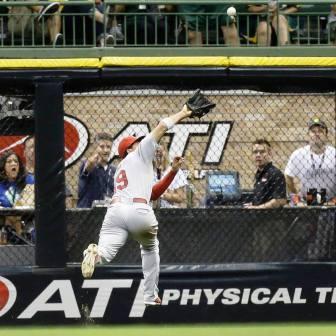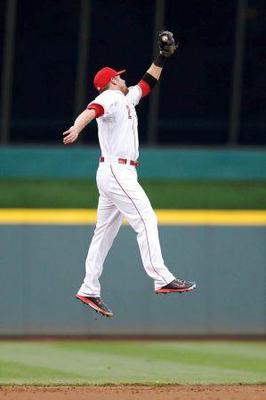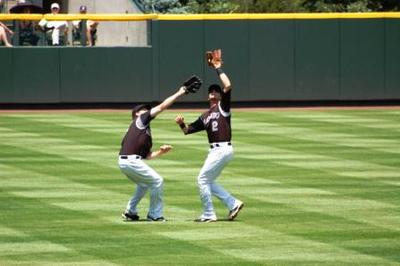Why the tag-up rule?

Great running catch at the wall.

Shortstop getting up high to catch line drive.

Left fielder, shortstop converging on pop fly
Anonymous asked: What is the purpose of the tag-up rule on fly balls?
You don't have to tag up after a fielder handles a grounder, so why after a fly?
I can't see any rational purpose for this.
Rick answered: Thank you for your question.
You would certainly had to have been there in the moment to gain an understanding of the rationale surrounding the entire rules creation for the game of baseball, at the time of it's inception.
While, over time, some rules have been adjusted or changed, baseball's rules in the present are not much different than when originally put into play.
In 1858, a partial change to the fly ball rule was created, which said that "a batter is out on a batted ball, fair or foul, if caught on the fly or after one bounce."
Apparently prior to 1858, that wasn't the case.
In 1895, the infield fly rule was adopted. The rationale for this rule was to prevent fielders from intentionally dropping pop flies, with less than 2 outs and in or near the infield area, with runners on first and second, or bases loaded.
Because base runners had to tag up to advance on the catch, infielders soon realized that when the ball went up, the runners tagged. By intentionally dropping, or letting the ball drop, they were able to pick it up and turn it into a double play, as the runners were 90 feet away from the next base, and were being forced to move by the batter-runner.
A good rule addition made to clear up an unfair advantage for the defense.
As you look at the photos above, the first one is an outfielder about to make a great running catch on a deep fly ball.
In this scenario, let's say the bases are loaded, and there is one out.
Without a "tag" rule, all three runners would be off at the crack of the bat. The outfielder makes a great catch at wall for out number 2, as the runner's from third and second base score easily. The runner from first base may also score, depending on his speed and whether or not the outfielder ran into the fence.
With the "tag" rule in effect, generally speaking the runner on 3B will tag, as will the runner from 2B. The runner from 1B will generally go as far as he feels comfortable without touching second base.
On the catch, the runner from 3B will score. The runner from 2B will go to third and the runner from 1B will return to 1B. One run scores, one runner advances a base and one remains where he was. Batter is out number 2.
The second photo is of a shortstop going up and snagging a line drive as it is headed for the outfield. Great catch; but with no "tag" rule and the bases loaded as in our first scenario, the batter will be out; but one run will score and the other two runners will advance one base.
With the "tag" rule, batter is out, no runners advance, and a runner may possibly get doubled off if not back on the base.
In the third photo, you have a pop fly in short left field, converged upon by the shortstop and left fielder.
The height of a pop up will allow, with a "no tag" rule, at least the runner from third to score, and quite possibly the runner from second, with the runner from first ending up on third base.
I believe that the "tag rule" allows the defense to be rewarded for a great catch, a pitcher making a super pitch to get a hitter to pop up, or a defensive player making a tremendous play on a line drive. Without the rule, while there is a great defensive effort to get one out, the number of runs that score in these instances is too one sided.
The "tag" rule adds much to the interest and strategy played out in the game.
Due to the way the rules are set up, there are 25 ways that a runner can score from third base; but not from second base.
Each situation on the list happens with varying frequency; but all contain one common thread, none of the 25 become a possibility until a base runner is occupying third base.
Just another example of situations created within the structure of the rules. Over time, it has led to a truly interesting game to play, as well as watch. Sometimes subtle, sometimes in full view, the game has almost an uncanny attraction to those who have played it as well as those who have never played it.
The dimensions of the playing field have withstood the test of time. Even with the advanced strength, size and speed of today's players, 90 foot bases compute just as well as they did at it's inception.
The League fooled around with the height of the mound in 1969, over concerns that pitching was becoming dominant, thus creating a less than exciting product for fans.
Dropping the mound 5 inches in height did create more offense, deemed a greater fan attraction than low scores and defensive battles. At that time they also shrunk the strike zone from the arm pits to the top of the batter's knees. Result? More offense, less strikeouts.
As you look inside the game, the "tag" rule is one small part of an integrated set of rules which make baseball the interesting, somewhat complex, sport that it is.
I do not know what the actual reasoning for the original rules were; but they surely have withstood the test of time!
Yours in baseball,
Rick





